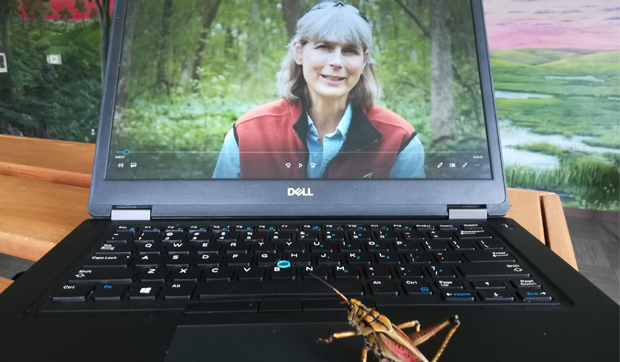On Tuesday June 16 at 8pm, Good Natured will take to the airwaves with its very first webcast. The hour-long show will take an up-close look at current nature topics and feature special guests of a decidedly wild nature.
Good Natured: The Good Natured Hour
June 5, 2020
As we slowly crawl from our quarantine-kindled cocoons, many of us are looking at the days ahead as a sort of rebirth. We’re vowing to find joy in every day; to bring kindness to the world; and to make the most of each and every moment.
Some would say they are blossoming into beautiful butterflies, spreading their wings and attaining new heights. Others might go more the route of moths, just as talented but in a stockier, hairier and often nocturnal fashion.
Me? Well, I’m taking the grasshopper approach. I’m changing, but in a much more gradual way.
Entomologists will explain that insects basically have two ways in which they mature: complete and incomplete or gradual metamorphosis.
Butterflies, moths, beetles, flies, bees and wasps all have an immature form that is quite different from their adult phase. Butterflies and moths start out as caterpillars, beetles for the most part begin as grubs; baby flies are maggots and baby bees and wasps go by the word larvae, a more generic term that actually can be applied to any of these youngsters undergoing complete metamorphosis.
When these juveniles pupate, astounding transformations occur inside their pupal case, which may be a chrysalis or cocoon, or simply the hardened shell of their last shed. When they reappear after a period of weeks or months, they do not resemble their immature form in the least. They have long legs! Their mouthparts are rearranged! They can fly!
Grasshoppers, meanwhile, do no such thing. A young grasshopper looks a lot like the adults who created it. Even the wings are present, but in really tiny hoppers the little pads are hard to see. Over time the grasshopper grows and molts, then grows and molts some more. Its legs and wings keep getting bigger and stronger until one day, whammo! It’s time to take that first giant leap.
So why do you suppose we’re this week talking about a topic that, compared to what’s going on in the nature world right this minute, is kinda mundane? I mean, frogs are calling, birds are nesting, and the monarchs are back and looking for milkweed. Awesome, amazing nature is in full swing!
Well, here’s the deal: Good Natured, this column that I’ve written for nigh onto 12 years now, is undergoing a transformation, and taking me with it.
Save for one brief experiment with video in the early 2010s, Good Natured always has consisted of words-about 800 or so-arrayed on newsprint or across a computer screen. In the early days, it didn’t even merit a photo. It was just a few rambling paragraphs about natural phenomenon like why lightning bugs blink or where worms go when it rains. The nature news, so to speak, always was followed by announcements of upcoming nature programs that related to the topic du jour.
Then, as our park district programming shifted, the promotional blurbs ceased and I gradually grew wordier. Another growth phase occurred when photos were added to the column. Its name, Good Natured, started to get some name recognition, and its reach expanded to include readers of Kane County Connects.
So now here we are in 2020, looking ahead to a summer unlike any we’ve ever experienced. The whole social distancing phenomenon will have an effect on virtually every activity the park district offers. Except for virtual ones! And that’s where The Good Natured Hour comes in.
Starting Tuesday June 16 and running at least through the summer, we’re going to be launching-like a grasshopper springing from a leaf–an online version of Good Natured. Part talk show, part variety show, The Good Natured Hour will run from 8pm to 9pm and take a live and up-close look at the column’s current topic, supplementing it with video footage and one-on-one interviews with local characters.
We’ll be using the Zoom video conferencing platform, and guests will include insects, reptiles, amphibians, mammals and birds-or parts thereof-as well as, from time to time, humans who are making a positive impact on our local environment.
In order to fund the care and feeding of our education (and possible Good Natured Hour guest) animals, we’ll be charging a weekly fee of $2. Think of it as a $2 Tuesday event that you don’t have to leave home to enjoy.
Sound like fun? You can bet it will be! You can find more information and find out how to sign up on the park district’s e-Activities page, https://www.stcparks.org/eactivities/
Pam Otto is the outreach ambassador for the St. Charles Park District. She can be reached at 630-513-4346 or potto@stcparks.org.

